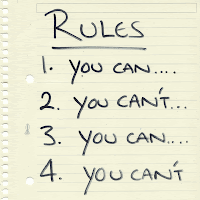The "Structure-Dependent" Child on the Autism Spectrum
Having a set of rules to follow on a day-to-day basis is the most important issue for an Aspergers or high-functioning autistic (HFA) child who is “structure-dependent.” Once this child has a list of DOs and DONTs to follow, there tends to be few concerns except in areas where the parent has not yet established rules, in which case the structure-dependent youngster becomes confused.
Any environment (e.g., home, classroom) where there is lax structure will be a difficult one for the structured-dependent youngster. This child needs rules in order to function and will probably create his own set of rules if parents and teachers don't provide them, which may create problems since the child’s rules will probably not match the adult’s expectations.
The structure-dependent youngster respects authority figures and does well when it is very clear who makes the rules and enforces them. This youngster often does very well in school, but may have behavioral problems at home if the rules are not as clear as they are in the classroom. It is not unusual for moms and dads of this child to be quite surprised to hear how well behaved she is at school.
There are two types of structure-dependent children with ASD:
Any environment (e.g., home, classroom) where there is lax structure will be a difficult one for the structured-dependent youngster. This child needs rules in order to function and will probably create his own set of rules if parents and teachers don't provide them, which may create problems since the child’s rules will probably not match the adult’s expectations.
The structure-dependent youngster respects authority figures and does well when it is very clear who makes the rules and enforces them. This youngster often does very well in school, but may have behavioral problems at home if the rules are not as clear as they are in the classroom. It is not unusual for moms and dads of this child to be quite surprised to hear how well behaved she is at school.
There are two types of structure-dependent children with ASD:
- The “acting-out” type
- The “acting-in” type
The “Acting-out” Type--
The acting-out youngster is often seen as a teacher's delight because he is rarely a discipline problem, but at home, this child’s behavior can be totally out of control (e.g., bossy, controlling, tantrums, meltdowns, yelling, arguing etc.). The key to recognizing this type of child is the behavior differences between school and home. If he experiences behavioral problems at school AND at home, then he is not a structure-dependent youngster.
The "acting-out" structure-dependent youngster:
- can be somewhat naive and taken advantage of since he doesn’t stand up for himself
- can become distressed by peers who do not follow the rules
- doesn't want anyone to be upset with him
- is often very cooperative with authority figures, sometimes to a fault
- likes to please others
- often becomes the "rule cop" in the classroom
- tends to monitor other peers’ and will "tell on them" in they break a rule
- tries to "fly under the radar"
This child has some anxiety issues, but not to the point where it is overwhelming for him. He manages his anxiety by following the rules – and making sure others do as well. Problems only occur for this child when rules are absent or vague, or when the adult in charge lacks authority in his opinion.
How parents and teachers can help the “acting-out” child:
Written rules, routines and schedules are some of the techniques used to create proper structure for this youngster – no matter how small the issue might be. There is no such thing as a situation that is too small to have rule. Even the “little things” need rules (e.g., going to a store, taking a bath, sharpening a pencil, raising your hand, etc.). Parents and teachers should supply a set of rules regarding appropriate behaviors to be demonstrated in each situation. Also, be sure to explain why there is a rule for such and such. This will help the child to generalize these skills later on.
Teachers who run highly structured classrooms may not need to do much of this. Instead, they may want to help the structure-dependent youngster be less rule-bound and have a greater tolerance for ambiguity.
The “Acting-in” Type--
This type of structure-dependent youngster is similar to the one above, except his behavior is good at home AND at school. He is also rule-bound with rules for everything, but unlike the acting-out child, this child has learned to control tantrums and anger – sometimes too much – in all situations. He views his parent, who has created many rules for him to follow at home, as an authority figure just like his teacher. There are very few situations that don't have rules for him to abide by. However, this child can be obedient to a fault, perfectionistic, obsessive-compulsive, and/or depressed. Thus, he needs to become more flexible.
How parents and teachers can help the “acting-in” child:
The adults need not worry about rules with this child; rather, a crash course in expressing emotions, as well as flexibility to help her see the world as less black-and-white would be helpful. This child needs to learn more about the “reasons behind actions” and how the world works, with less emphasis on unwavering compliance. Without throwing out the rules altogether, help this child to develop decision-making and problem-solving skills so that she can become a more independent thinker.
More resources for parents of children and teens with Asperger's and High-Functioning Autism:



